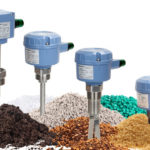Point level switches provide limit detection, which is needed in most vessels and silos to prevent overfilling and run-dry situations, both of which can have extremely serious and costly consequences. Overfills can cause safety risks to personnel and damage to the vessel and the surrounding environment, which in turn would produce a loss of storage capacity whilst repairs took place, while run-dry situations can disrupt a process or even stop production. Organisations must therefore minimise risk by installing point level switches as part of an effective safety instrumented system.
Due to the diverse nature of the solids materials and process conditions encountered in the chemical industry, there is no ‘one size fits all’ solution for limit detection, and various point level switch technologies are well proven. Selection is typically based on the size and space constraints of the vessel, and the application conditions. Let’s look at the different point level switch technologies and the applications to which they are best suited.
Easy mountable paddle switches
Paddle switches can be easily mounted through the wall of a vessel and positioned where limit detection is needed. Their operation is based on a small internal electric motor continuously rotating a paddle. In free air, the paddle can rotate freely at the full speed of the motor. However, when the paddle is impeded by the material, the rotation is slowed or stopped, causing a microswitch to actuate an alarm signal. When the paddle has stopped rotating, power to the motor is cut. When the material level falls, the microswitch restarts the motor, enabling the paddle to rotate freely again. The robustness of the paddle design makes these switches suitable for extreme process conditions such as high pressures and high temperatures. This makes them a cost-effective option for small process vessels and most bulk solids, and a widely applied solution in applications involving granular, pelletised and powdered products.
Reliable vibrating fork switches
The vibrating fork switches have twin prongs, which an internal piezo-electric crystal causes to vibrate at their natural frequency when in free air. The frequency varies when the prongs are immersed in the material, thereby enabling the presence or absence of material to be identified. The switch’s electronics detect frequency variation, and the output state is then changed. Vibrating fork switches are reliable and have low maintenance requirements because the devices have no moving parts to wear or stick. The compact nature of these switches makes them ideal for vessels where space is limited. They are suitable when high sensitivity is required, they perform well with low bulk density, fine-grained and fine-powdered products, and they can withstand high mechanical loads because of their short extension length. Vibrating fork switches with wetted parts made from corrosion-resistant stainless steel are suitable for use in hygienic applications, such as in the food industry.
Compact vibrating rod switches
As with vibrating fork switches, vibrating rod switches use piezo-electric vibration technology to energise the rod and keep it vibrating at its natural frequency in free air. As the level in the vessel rises, the vibration is dampened, and when the electronics detect material covering the rod, the switching of the output relay is initiated. As the level descends and the rod is again in free air, the vibration restarts and the relay switches back. These switches have high sensitivity, are unaffected by dust, and are suitable for hygienic applications when constructed from stainless steel. The single rod design eliminates the possibility of material build-up causing blocking or bridging, which can affect vibrating fork technology performance. They are a suitable solution for fine-grained and powdered products, and their compact design makes them a superior choice in vessels with limited space. In addition, they can withstand high mechanical loads and are reliable, with low maintenance requirements.
All-round capacitance switches
These switches form a capacitor when installed in a vessel, to detect whether they are covered by the material. A probe acts as one plate of the capacitor, and the vessel wall (or reference electrode in a non-metallic vessel) acts as the other plate. As the product level rises, the air surrounding the probe is displaced by material with a different dielectric constant. Because the dielectric between the plates has changed, a change in the value of the capacitor takes place. The switch detects this and converts it into a relay actuation or proportional output signal. Capacitance switches can tolerate challenging process conditions, including variable density, low dielectric values, high temperatures and high pressures, making it a good all-round technology, suitable for use with most bulk materials, regardless of particle size. These switches are particularly suitable in applications where there is a risk of coating or high levels of vibration.
Four technologies in one range
The vibrating fork, paddle, capacitance and vibrating rod switches within the Rosemount range from Emerson require low levels of maintenance and are suitable for operation in extremely challenging environments, including those with high temperatures, high pressures, dust and risk of explosion. The switches can be used to provide standalone point level monitoring to help optimise filling and emptying cycles. They can also be deployed within an overfill prevention system, helping to prevent wasted materials, environmental impact, high clean-up costs and damage to the silo.
In applications involving light, fine-grained and powdered materials where high measurement sensitivity is required, Rosemount 2511 and 2521 vibrating fork switches provide a cost-effective solution. European Commission Atex certification permits installation in explosive areas, and all wetted parts are made from corrosion-resistant stainless steel, making them suitable for use in hygienic applications. The Rosemount 2501 rotary paddle switch can be used as a full, demand or empty detector in storage silos or process vessels. The robust paddle design can withstand heavy loads and extreme temperatures of up to 1100 °C.
The Rosemount 2555 capacitance switch can be installed in pipes as a limit switch and spillage detector. The switch is suitable for use with materials that have dielectric values as low as 1.5 and is designed to prevent material build-up in applications where there is a risk of coating. The Rosemount 2535 vibrating rod switch provides high chemical resistance due to the fact that it is completely made of food-grade stainless steel.
Although measuring the level of solids can be challenging, advanced technologies currently available are able to meet the demands of these applications. With careful consideration of the specific application conditions, installation constraints and capabilities of the different technology options, it is possible to provide accurate and reliable level measurement solutions that increase plant safety and efficiency.
Emerson Process Management GmbH & Co. OHG, Langenfeld









